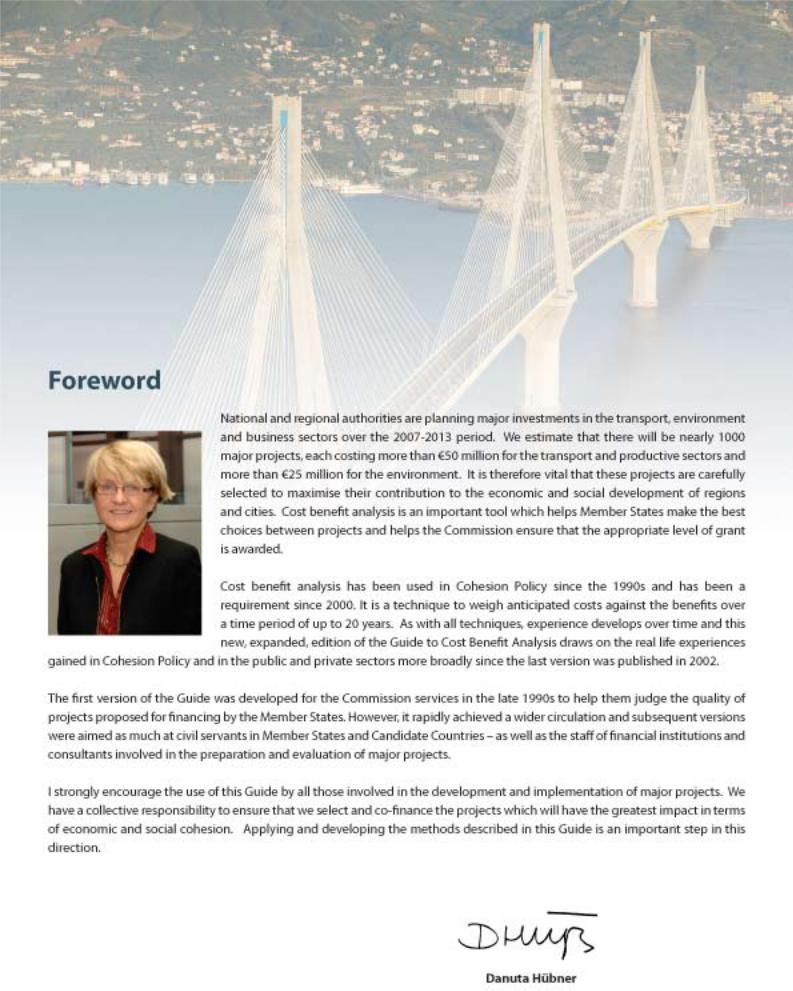
guide2008_en
.pdf


EUROPEAN COMMISSION
Directorate General Regional Policy
Guide to COST-BENEFIT ANALYSIS
of investment projects
Structural Funds, Cohesion Fund and Instrument for Pre-Accession
2008

The CBA Guide Team
This Guide has been written by a team selected by the Evaluation Unit, DG Regional Policy, European Commission, through a call for tenders by restricted procedure following a call for expressions of interest n. 2007.CE.16.0.AT.024.
The selected team of TRT Trasporti e Territorio (Milano) in partnership with CSIL Centre for Industrial Studies (Milano), is composed of:
-Professor Massimo Florio, Project Scientific Director, CSIL and University of Milan.
-Dr. Silvia Maffii, Project Coordinator, TRT.
-Scientific Advisors: Dr. Giles Atkinson, London School of Economics and Political Science (UK); Professor Ginés De Rus, University of Las Palmas (Spain); Dr. David Evans, Oxford Brookes University (UK); Professor Marco Ponti, Politecnico, Milano (Italy).
-Project evaluation experts: Mario Genco, Riccardo Parolin, Silvia Vignetti.
-Research assistants: Julien Bollati, Maurizia Giglio, Giovanni Panza, Davide Sartori.
The authors are grateful for very helpful comments from the EC staff and particularly to Veronica Gaffey and Francesco Maria Angelini (Evaluation Unit) and to the participants in the meetings of the Steering Committee, including experts from EIB, JASPERS and desk officers from several Geographical Units at DG Regio. The authors are fully responsible for any remaining errors or omissions.
Disclaimer
The European Commission and the CBA Guide team accept no responsibility or liability whatsoever with regard to this text. This material is:
-Information of general nature which is not intended to address the specific circumstances of any particular individual or entity.
-Not necessarily comprehensive, accurate or up to date.
-Not professional or legal advice.
Reproduction or translation is permitted, provided that the source is duly acknowledged and no modifications to the text are made.

ACRONYMS AND ABBREVIATIONS
BAU |
Business As Usual |
B/C |
Benefit/Cost Ratio |
CBA |
Cost-Benefit Analysis |
CEA |
Cost-Effectiveness Analysis |
CF |
Cohesion Fund, Conversion Factor |
DCF |
Discounted Cash Flow |
EBRD |
European Bank for Reconstruction and Development |
EC |
European Commission |
EIA |
Environmental Impact Assessment |
EIB |
European Investment Bank |
EIF |
European Investment Fund |
ELF |
Environmental Landscape Feature |
ENPV |
Economic Net Present Value |
ERDF |
European Regional Development Fund |
ERR |
Economic Rate of Return |
ESF |
European Social Fund |
EU |
European Union |
FDR |
Financial Discount Rate |
FNPV |
Financial Net Present Value |
FRR(C) |
Financial Rate of Return of the Investment |
FRR(K) |
Financial Rate of Return of Capital |
IPA |
Instrument for Pre-Accession Assistance |
IRR |
Internal Rate of Return |
LRMC |
Long Run Marginal Cost |
MCA |
Multi-Criteria Analysis |
MS |
Member State |
MCPF |
Marginal Cost of Public Funds |
NEF |
Noise Exposure Forecast |
NSRF |
National Strategic Reference Framework |
OP |
Operational Programme |
PPP |
Public-Private Partnership |
QALY |
Quality-Adjusted Life Year |
SCF |
Standard Conversion Factor |
SDR |
Social Discount Rate |
SER |
Shadow Exchange Rate |
STPR |
Social Time Preference Rate |
SEA |
Strategic Environmental Assessment |
SF |
Structural Funds |
TEN-E |
Trans-European Energy Network |
TEN-T |
Trans-European Transport Network |
VAT |
Value Added Tax |
WTP |
Willingness-to-pay |
3
4

TABLE OF CONTENTS
INTRODUCTION AND SUMMARY |
13 |
|||
CHAPTER ONE |
PROJECT APPRAISAL IN THE FRAMEWORK OF THE EU FUNDS |
19 |
||
OVERVIEW |
|
|
19 |
|
1.1 |
CBA SCOPE AND OBJECTIVES |
19 |
||
1.2 |
DEFINITION OF PROJECTS |
20 |
||
1.3 |
INFORMATION REQUIRED |
22 |
||
1.4 |
RESPONSIBILITY FOR PROJECT APPRAISAL |
23 |
||
1.5 |
DECISION BY THE COMMISSION |
26 |
||
CHAPTER TWO |
AN AGENDA FOR THE PROJECT EXAMINER |
27 |
||
OVERVIEW |
|
|
27 |
|
2.1 |
CONTEXT ANALYSIS AND PROJECT OBJECTIVES |
28 |
||
|
2.1.1 |
Socio-economic context |
28 |
|
|
2.1.2 Definition of project objectives |
28 |
||
|
2.1.3 Consistency with EU and National Frameworks |
29 |
||
2.2 |
PROJECT IDENTIFICATION |
29 |
||
|
2.2.1 What is a project? |
30 |
||
|
2.2.2 Indirect and network effects |
30 |
||
|
2.2.3 |
Who has standing? |
31 |
|
2.3 |
FEASIBILITY AND OPTION ANALYSIS |
32 |
||
|
2.3.1 |
Option identification |
32 |
|
|
2.3.2 |
Feasibility analysis |
33 |
|
|
2.3.3 |
Option selection |
33 |
|
2.4 |
FINANCIAL ANALYSIS |
34 |
||
|
2.4.1 |
Total investment costs |
36 |
|
|
2.4.2 Total operating costs and revenues |
39 |
||
|
2.4.3 Financial return on investment |
40 |
||
|
2.4.4 |
Sources of financing |
42 |
|
|
2.4.5 |
Financial sustainability |
43 |
|
|
2.4.6 Financial return on capital |
45 |
||
2.5 |
ECONOMIC ANALYSIS |
47 |
||
|
2.5.1 Conversion of market to accounting prices |
50 |
||
|
2.5.2 Monetisation of non-market impacts |
54 |
||
|
2.5.3 Inclusion of indirect effects |
56 |
||
|
2.5.4 |
Social discounting |
57 |
|
|
2.5.5 Calculation of economic performance indicators |
57 |
||
2.6 |
RISK ASSESSMENT |
60 |
||
|
2.6.1 |
Sensitivity analysis |
60 |
|
|
2.6.2 Probability distributions for critical variables |
63 |
||
|
2.6.3 |
Risk analysis |
63 |
|
|
2.6.4 Assessment of acceptable levels of risk |
64 |
||
|
2.6.5 |
Risk prevention |
65 |
|
2.7 |
OTHER PROJECT EVALUATION APPROACHES |
66 |
||
|
2.7.1 |
Cost-effectiveness analysis |
66 |
|
|
2.7.2 |
Multi-criteria analysis |
67 |
|
|
2.7.3 |
Economic impact analysis |
69 |
|
CHAPTER THREE |
OUTLINES OF PROJECT ANALYSIS BY SECTOR |
71 |
||
OVERVIEW |
|
|
71 |
|
3.1 |
TRANSPORT |
|
71 |
|
|
3.1.1 |
Transport networks |
71 |
|
|
3.1.2 CBA of High Speed Rail investment in Europe |
82 |
||
|
3.1.3 Ports, airports and intermodal facilities |
84 |
||
5
3.2 |
ENVIRONMENT |
86 |
||
|
3.2.1 |
Waste treatment |
86 |
|
|
3.2.2 Water supply and sanitation |
93 |
||
|
3.2.3 |
Natural risk prevention |
104 |
|
3.3 |
INDUSTRY, ENERGY AND TELECOMMUNICATIONS |
107 |
||
|
3.3.1 Industries and other productive investments |
107 |
||
|
3.3.2 Energy transport and distribution |
110 |
||
|
3.3.3 Energy production and renewable sources |
112 |
||
|
3.3.4 |
Telecommunications infrastructures |
117 |
|
3.4 |
OTHER SECTORS |
119 |
||
|
3.4.1 Education and training infrastructures |
119 |
||
|
3.4.2 Museums and cultural sites |
122 |
||
|
3.4.3 Hospitals and other health infrastructures |
123 |
||
|
3.4.4 |
Forests and parks |
126 |
|
|
3.4.5 Industrial zones and technological parks |
127 |
||
CHAPTER FOUR |
CASE STUDIES |
131 |
||
OVERVIEW |
|
|
131 |
|
4.1 |
CASE STUDY: INVESTMENT IN A MOTORWAY |
132 |
||
|
4.1.1 |
Introduction |
132 |
|
|
4.1.2 |
Traffic forecast |
132 |
|
|
4.1.3 |
Investment costs |
133 |
|
|
4.1.4 |
Economic analysis |
134 |
|
|
4.1.5 |
Scenario analysis |
138 |
|
|
4.1.6 |
Risk assessment |
138 |
|
|
4.1.7 |
Financial analysis |
139 |
|
4.2 |
CASE STUDY: INVESTMENT IN A RAILWAY LINE |
146 |
||
|
4.2.1 |
Introduction |
146 |
|
|
4.2.2 |
Traffic analysis |
146 |
|
|
4.2.3 |
Investment costs |
147 |
|
|
4.2.4 |
Economic analysis |
148 |
|
|
4.2.5 |
Scenario analysis |
150 |
|
|
4.2.6 |
Risk assessment |
151 |
|
|
4.2.7 |
Financial analysis |
152 |
|
4.3 |
CASE STUDY: INVESTMENT IN AN INCINERATOR WITH ENERGY RECOVERY |
158 |
||
|
4.3.1 Project definition and option analysis |
158 |
||
|
4.3.2 |
Financial analysis |
158 |
|
|
4.3.3 |
Economic analysis |
160 |
|
|
4.3.4 |
Risk assessment |
162 |
|
4.4 |
CASE STUDY: INVESTMENT IN A WASTE WATER TREATMENT PLANT |
170 |
||
|
4.4.1 |
Project definition |
170 |
|
|
4.4.2 |
Financial analysis |
172 |
|
|
4.4.3 |
Economic analysis |
175 |
|
|
4.4.4 |
Risk assessment |
177 |
|
4.5 |
CASE STUDY: INDUSTRIAL INVESTMENT |
188 |
||
|
4.5.1 |
Project objectives |
188 |
|
|
4.5.2 |
Project identification |
188 |
|
|
4.5.3 Feasibility and option analysis |
188 |
||
|
4.5.4 |
Financial analysis |
189 |
|
|
4.5.5 |
Economic analysis |
191 |
|
|
4.5.6 |
Risk assessment |
192 |
|
ANNEXES |
|
|
201 |
|
ANNEX A |
DEMAND ANALYSIS |
202 |
||
ANNEX B THE CHOICE OF THE DISCOUNT RATE |
207 |
|||
ANNEX C PROJECT PERFORMANCE INDICATORS |
211 |
|||
ANNEX D THE PROJECT’S IMPACT ON EMPLOYMENT AND THE OPPORTUNITY COST OF LABOUR |
215 |
|||
6 |
|
|
|
|
ANNEX E |
AFFORDABILITY AND EVALUATION OF DISTRIBUTIVE IMPACT |
217 |
ANNEX F |
EVALUATION OF HEALTH & ENVIRONMENTAL IMPACTS |
222 |
ANNEX G |
EVALUATION OF PPP PROJECTS |
232 |
ANNEX H |
RISK ASSESSMENT |
236 |
ANNEX I |
DETERMINATION OF THE EU GRANT |
242 |
ANNEX J |
TABLE OF CONTENTS OF A FEASIBILITY STUDY |
243 |
GLOSSARY |
|
246 |
BIBLIOGRAPHY |
250 |
|
7
8
